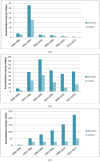Thyroid Cancer in Regions Most Contaminated after the Chernobyl Disaster
- PMID: 39027710
- PMCID: PMC11252555
- DOI: 10.31661/jbpe.v0i0.2402-1722
Thyroid Cancer in Regions Most Contaminated after the Chernobyl Disaster
Abstract
Exposure to ionizing radiation, especially during childhood, is a well-established risk factor for thyroid cancer. Following the 1986 Chernobyl nuclear power plant accident the total number of cases of thyroid cancer registered between 1991 and 2015 in males and females who were less than 18 years old exceeded 19,000 (in Belarus and Ukraine, and in the most contaminated oblasts of the Russian Federation). However, as indicated by the United Nations Scientific Committee on the Effects of Atomic Radiation the fraction of the incidence of thyroid cancer attributable to radiation exposure among the non-evacuated residents of the contaminated regions of Belarus, Ukraine and Russia is of the order of 0.25. Apparently, the increased registration of thyroid neoplasms in the parts of these countries is a classical 'screening effect', i.e., massive diagnostic examinations of the risk-aware populations performed with modern eqipment resulting in detection of many occult neoplasms (incidentalomas). Moreover, one type of thyroid cancer previously called 'encapsulated follicular variant of papillary thyroid carcinoma' is non-invasive and instead of 'carcinoma' should now be recognized as 'noninvasive follicular thyroid neoplasm with papillary-like nuclear features.' Other potential causes of overdiagnosing of thyroid tumors include increase of the spontaneous incidence rate of this disease with age, iodine deficiency among children from Belarus, Russia and Ukraine, and/or consumption by these children of drinking water containing high levels of nitrates that likely coincides with the carcinogenic effect of radiation on the thyroid gland.
Keywords: Chernobyl Accident; Contamination; Incidence; Overdiagnosis; Radiation, Ionizing; Thyroid Cancer.
Copyright: © Journal of Biomedical Physics and Engineering.
Conflict of interest statement
None
Figures
Similar articles
-
Morphologic characteristics of Chernobyl-related childhood papillary thyroid carcinomas are independent of radiation exposure but vary with iodine intake.Thyroid. 2008 Aug;18(8):847-52. doi: 10.1089/thy.2008.0039. Thyroid. 2008. PMID: 18651805 Free PMC article.
-
[The effect of Chernobyl accident on the development of malignant diseases--situation after 20 years].Endokrynol Pol. 2006 May-Jun;57(3):244-52. Endokrynol Pol. 2006. PMID: 16832789 Review. Polish.
-
Thyroid consequences of the Chernobyl nuclear accident.Acta Paediatr Suppl. 1999 Dec;88(433):23-7. doi: 10.1111/j.1651-2227.1999.tb14399.x. Acta Paediatr Suppl. 1999. PMID: 10626541
-
Post-Chernobyl thyroid carcinoma in Belarus children and adolescents: comparison with naturally occurring thyroid carcinoma in Italy and France.J Clin Endocrinol Metab. 1997 Nov;82(11):3563-9. doi: 10.1210/jcem.82.11.4367. J Clin Endocrinol Metab. 1997. PMID: 9360507
-
Radiation dosimetry for highly contaminated Belarusian, Russian and Ukrainian populations, and for less contaminated populations in Europe.Health Phys. 2007 Nov;93(5):487-501. doi: 10.1097/01.HP.0000279019.23900.62. Health Phys. 2007. PMID: 18049225 Review.
Cited by
-
Papillary Thyroid Carcinoma With a Rare TFG-MET Fusion in a Chernobyl Survivor: A Case Report.Cureus. 2025 Jun 9;17(6):e85602. doi: 10.7759/cureus.85602. eCollection 2025 Jun. Cureus. 2025. PMID: 40636652 Free PMC article.
-
Chernobyl nuclear catastrophe: lessons for sustainability and UNSDGs in health, energy, and environmental recovery.Front Public Health. 2025 Feb 26;13:1552122. doi: 10.3389/fpubh.2025.1552122. eCollection 2025. Front Public Health. 2025. PMID: 40078765 Free PMC article.
-
Protracted exposure to 134Cs and 137Cs gives substantial contribution to long-term thyroid absorbed dose after nuclear power plant accidents.Radiat Prot Dosimetry. 2025 Aug 26;201(13-14):899-904. doi: 10.1093/rpd/ncaf035. Radiat Prot Dosimetry. 2025. PMID: 40875278 Free PMC article.
References
-
- Gembicki M, Stozharov AN, Arinchin AN, Moschik KV, Petrenko S, Khmara IM, Baverstock KF. Iodine deficiency in Belarusian children as a possible factor stimulating the irradiation of the thyroid gland during the Chernobyl catastrophe. Environ Health Perspect. 1997;105(Suppl 6):1487–90. doi: 10.1289/ehp.97105s61487. [ PMC Free Article ] - DOI - PMC - PubMed
-
- Robbins J, Schneider AB. Thyroid cancer following exposure to radioactive iodine. Rev Endocr Metab Disord. 2000;1(3):197–203. - PubMed
LinkOut - more resources
Full Text Sources

